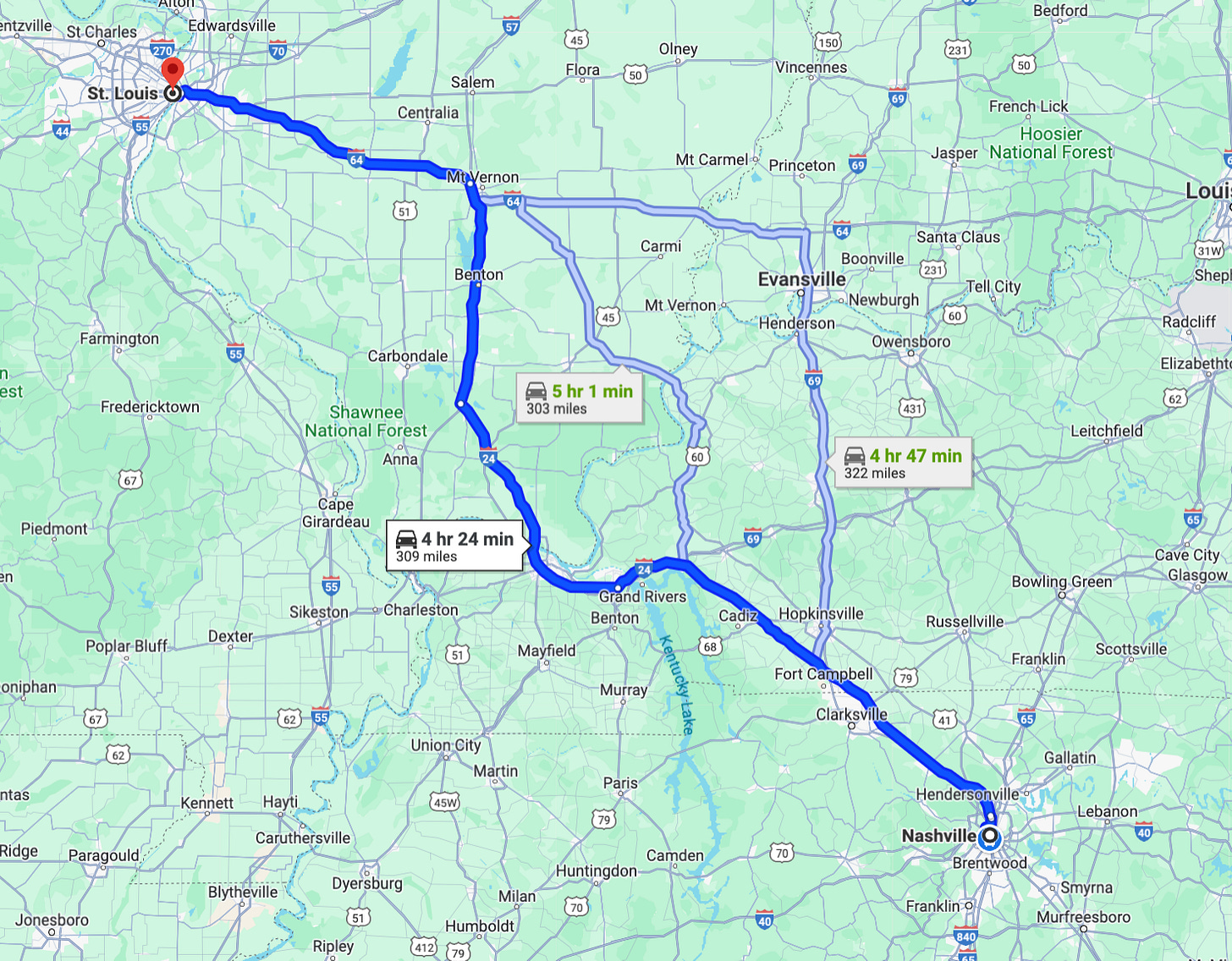The Index of all 30 posts from day 1 of our #TeslaRoadTripUSA is HERE.
Left Nashville at 7am with 328 miles of charge.
Was a lovely drive through Tennessee, through Clarkesville. We sang the Monkees song “The Last Train to Clarkesville”. I wondered if that was Glen Campbell playing guitar on that Wrecking Crew recording.
This was a three-state day. We crossed the State Line from Tennessee into Illinois and onto St. Louis, Missouri. Once the home of Tina Turner, the KKK and alcohol prohibitionist Christians.
Here are some car pictures from Illinois. We passed The Big Muddy River Correctional Center. A medium-security state prison for men located in Ina, Jefferson County, Illinois, owned and operated by the Illinois Department of Corrections.
The facility was first opened in 1993, and has a working capacity of 1958. It is notable for being the only state prison in Illinois to have a SDP (Sexually Dangerous Person) treatment program. How do they treat sexually dangerous people we wondered.
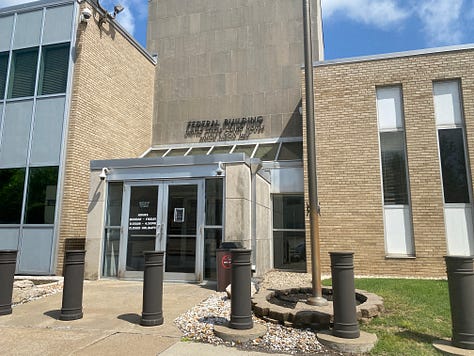


We drove through Benton and googled the veterans cemetery there. So many of these small towns have a big backstory.
Benton has two. On April 19, 1928, Benton was the site of the next-to-last public hanging in Illinois, when local Jewish Russian immigrant Charles Birger was hanged for the murder of Joe Adams, mayor of nearby West City, on April 19, 1928, at the Franklin County Jail in Benton. Charles Birger was born to a Jewish family in the Russian Empire. He emigrated to the United States as a child with his parents.
Following World War I, in 1919, the United States adopted national prohibition, which banned the sale, manufacture, and transportation of alcoholic beverages. Birger recognized this as a business opportunity and in 1920 joined forces with the Shelton Brothers. Charlie Birger and the Shelton Brothers Gang fought for control of the coal fields of southern Illinois, but their attention was diverted by a common enemy. In the 1920s, the Ku Klux Klan supported national prohibition.
Alcohol was regarded as an "un-American" vice practiced by White ethnic immigrants, many of whom were Roman Catholics and other religions. Many of these immigrants worked in the coal mines of southern Illinois, living mainly in very small towns while maintaining a strong ethnic pride. Alcohol was a part of their life, and bootlegging came naturally to them.
In the spring of 1923, the Klan began organizing in Williamson County, holding meetings attended by more than 5,000 people. The Klan drew its support from both the farming community and people in the larger towns, the latter mainly of Scotch-Irish origin and belonging to the Baptist and other traditional Protestant churches.
The Klan soon found a charismatic leader in Seth Glenn Young, a 58-year-old former federal law enforcement officer. Large mobs began going door to door, forcibly searching houses for alcohol. If alcohol was found, the occupants were taken to Klan "prisons". Federal authorities apparently had deputized the Klansmen to aid in the enforcement of Prohibition. In the 1920s, Southern Illinois was Klan Country. The Klan was experiencing its second Golden Age, as a Nativist movement crusading against alcohol, immigrants and Roman Catholics.
As a special agent of the Treasury Department’s Prohibition Unit, Seth Glenn Young was assigned to East St. Louis. He immediately proved himself to be a zealous prosecutor of bootlegging. After just four months on the job, Young shot and killed a man during a raid on a still. Young was put on trial for murder but found not guilty on the grounds of self-defense. He claimed that the bootlegger pulled a gun on him. The Prohibition Unit fired him, not for the killing, but for stealing $157.50 from a gambler and keeping it for himself; and for traveling with his mistress while on government business.
Young’s bosses “found him to be of a belligerent nature, prone to make threats of violence…and apparently convinced that he is a law within himself.”
On January 24, 1925, a shot was fired in the street in Herrin, Illinois. Deputy Sheriff Ora Thomas responded and walked into a cigar store where he saw Klan leader Young. Thomas drew his pistol and shot Young twice. Young was able to shoot Thomas once before falling to the floor. Two of Young's companions, fellow Klansmen Edward Forbes and Omer Warren joined in the melee, and all four men were fatally wounded. The Klan held a public funeral for Young that was attended by more than 15,000 people.
In April 1926, Charlie Birger and the Shelton Brothers joined forces to attack the remaining Klan leaders in Herrin, using Tommy guns and shotguns. The police were called repeatedly, but chose not to respond. Four Klansmen and two anti-Klansmen were killed in a shootout. The Klan buried its dead and the coroner ruled that their deaths were homicides "by parties unknown".
Although the Klan's losses were not large, the Herrin attack broke the back of the local KKK. Lawfully elected local officials returned to their offices, and Birger and the Shelton Brothers went back into business. In June 1927, Birger was arrested on a charge of ordering the contract killing of Mayor Joseph Adams. Birger allowed himself to be taken into custody without a fight. He had been arrested many times, and had always been released a few days later. He may not have realized that the trial was to take place in Franklin County, which his political allies did not control.
Birger and the two men who did the killing were convicted; however, only Birger was sentenced to hang. Birger objected that it was unfair he should receive the death penalty while the confessed trigger man was sentenced only to prison in return for his cooperation with investigators. Nevertheless, Birger was hanged for the murder of Adams on April 19, 1928, at the Franklin County Jail in Benton.
At Birger's request, he was accompanied to the gallows by a rabbi and wore a black hood rather than a white one, since he did not want to be mistaken for a Klansman. Charlie Birger was second to last man to be executed in a public hanging in Illinois. Charles Shader was hanged six months later on October 10, 1928. He shook hands with the hangman, the "humane hangman" Philip Hanna, and his final words were, "It's a beautiful world." (Local southern Illinois legend attests that Birger said "It's a beautiful day", in defiance, while the newspapers reported the remorseful "It's a beautiful world.")
Birger's place as a southern Illinois folk legend is recorded in John L. "Ox" Gwaltney's "Charlie Birger":
I heard of Charlie Birger way back when I was young
My daddy told me all about the day that Charlie hung.
I've heard so many stories, some of his ghastly deeds
Another tells how Charlie helped poor folks in their needs.
One said he was a kindly man who never told a lie
But when somebody crossed him, that man was sure to die
That Charlie had no Master you can tell from all the tales
He fought the system all the way, and stayed out of their jails
I've seen so many pictures, they're hanging on the walls
The pictures tell the story of Birger's rise and fall
And when they finally caught him he was sentenced to be hung
But they hadn't broke his spirit the day the trap was sprung
When the State had had its vengeance, when Charlie's life was done
It made one stop to wonder, Who had lost, and who had won.
John Lastle Gwaltney Southern Illinois Poetry (1985)
The second famous Benton story involves Liverpudlian George Harrison. George’s first visit to the United States saw him visiting his sister, who lived in Benton. While Paul McCartney and Ringo Starr went to Greece and John Lennon went to Paris, Harrison and his brother Peter went to southern Illinois to visit their sister Louise Harrison. Louise moved to Benton in March of 1963 with her husband who worked as a mining engineer. After her brother’s band gained recognition in the UK with their 1962 hit, Love Me Do, she took it on herself to promote The Beatles in the U.S.
George was 20 at the time he came to visit Louise in Benton. He spent much of the trip walking the streets of Benton. He bought a few records at Barton and Collins, including one by a new popular artist name of Roy. The song was “Got My Mind Set on You”. He would go on to cover that song in 1987. Harrison played Boccie Ball at the Boneyard Club and bought a guitar in Mt. Vernon that is now on display at the Rock and Roll Hall of Fame.
Benton played its part in making the Beatles famous in America.
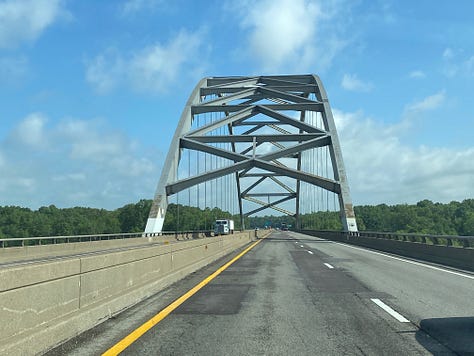
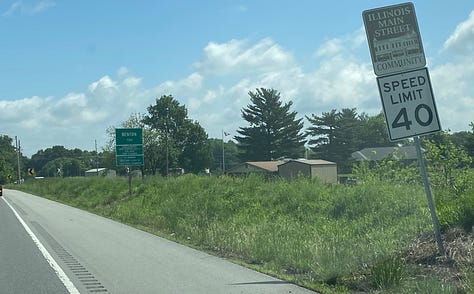
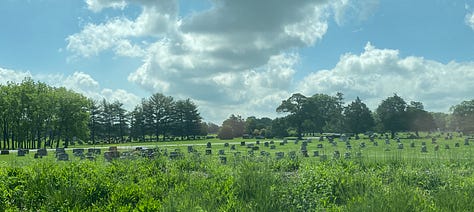
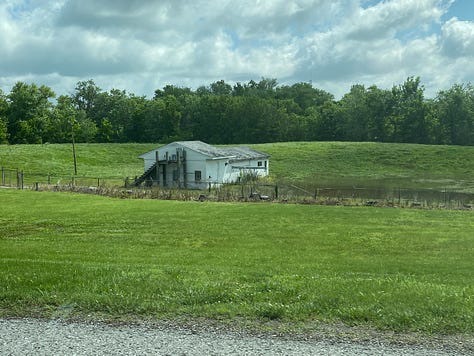



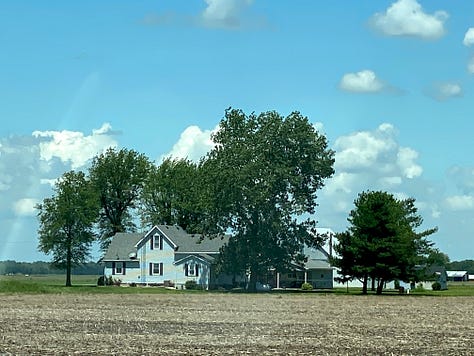

As usual, we were amazed at how many churches there are wherever we pass. In some areas there are more churches than residences.
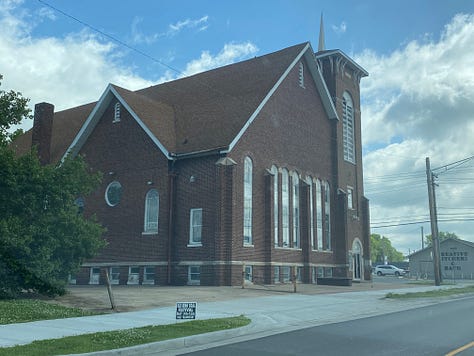
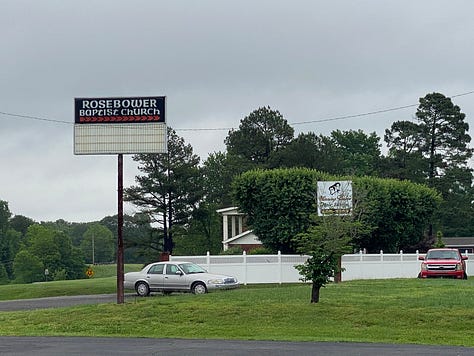
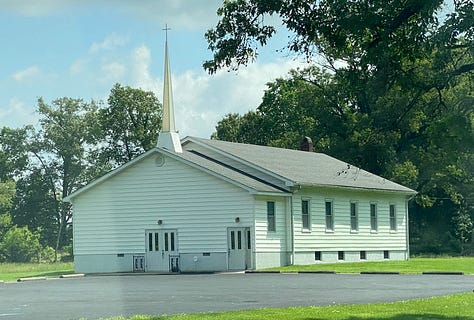
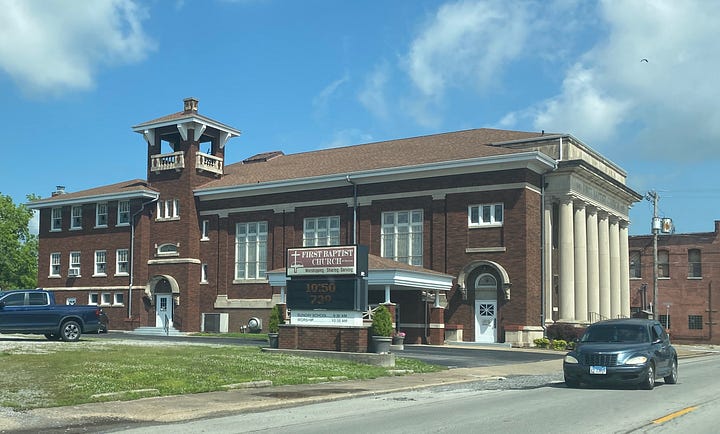

Past Franklin County jail museum. More fabulous country vistas
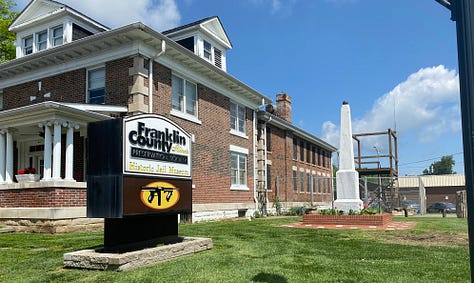
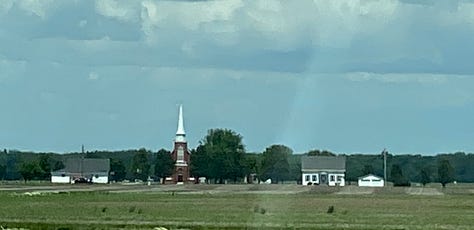

We arrived in St. Louis in 2024. Anna Mae Bullock arrived in St. Louis the 60’s. Anna Mae grew up in Nutbush, Tennessee but moved to St. Louis when she was a teenager. She attended Sumner High School and started performing at venues in East St. Louis.
Anna Mae recorded the lead vocals for Ike Turner’s song, “A Fool in Love,” in 1960 after singer Art Lassiter didn’t show up to the recording session.
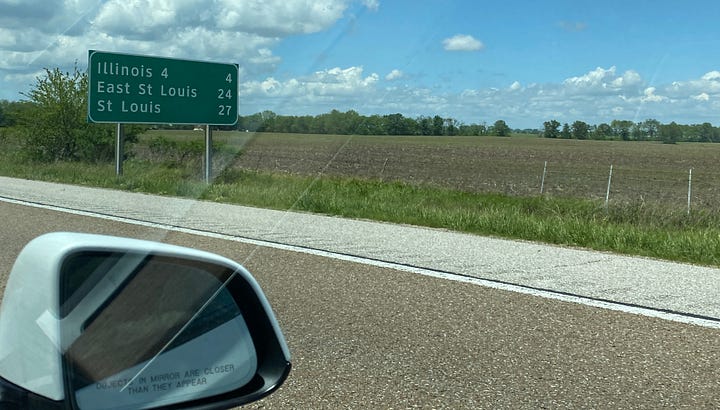

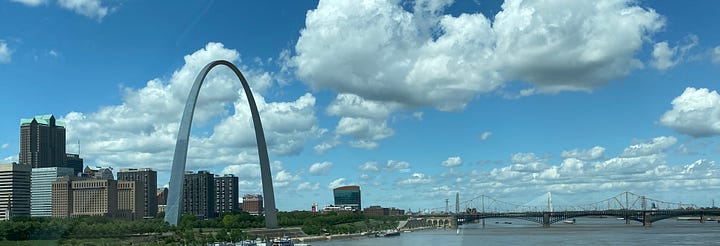
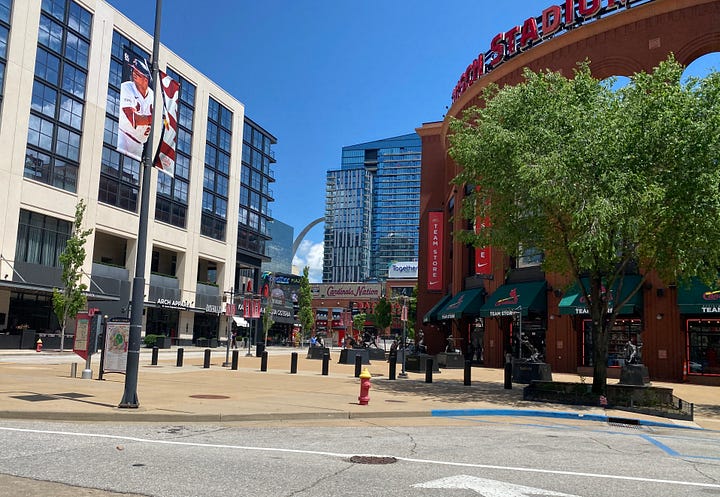
In the shadow of the St Louis arch is the courthouse. Here, between 1839 and 1862, Americans bid competitively at auction for ownership of over 500 men, women and children. I felt physically ill standing on the courthouse steps knowing this dark chapter of American history that helps me understand why so many Americans to this day feel entitled to to attack those of us objecting to their right to execute children en masse for their political expedience.
The guy we have to thank for this lucrative trade is Bernard Lynch. St. Louis's most proslavery, pro-Democrat party newspaper in the 1850s and 1860s was the confusingly-titled Missouri Republican. Bernard Lynch regularly posted advertisements for his business in the newspaper. This advertisement from the August 4, 1860 edition reads as follows:
B.M. Lynch has removed to his large, airy, new quarters, No. 57 South Fifth street, corner of Myrtle. He will pay the highest prices known to the trade for all descriptions of negroes suited to the Southern markets. Will also board and sell on commission. Thankful for past favors, he solicits a continuance of public patronage. Negroes on hand and for sale at all times.
Another advertisement from an anonymous patron underneath Lynch's advertisement reads:
For Sale--A very likely intelligent MULATTO BOY, between ten and twelve years of age. Is a good hand to wash dishes, wait on the table, take care of children, run on errands, &c. Address postoffice, box 2,577.
Lynch was the most prominent trader of enslaved people in St. Louis. His primary trade site was known as “Lynch’s Slave Pen” and was located at 5th and Myrtle streets. This prison incarcerated enslaved people about to be sold at auction, freedom seekers who had been captured, and free Blacks who had violated the law.
These people were regularly subjected to violent punishments by Lynch’s employees. Auctions occurred at least once a week near the St. Louis Courthouse.
Lynch abandoned his prison when the U.S. military seized it at the beginning of the Civil War in 1861. Ironically, the U.S. military kept Confederate prisoners at the site during the war. As St. Louis historian Angela da Silva points out, “Bernard M. Lynch’s slave pen turned into a prison for the same people who went shopping there [before the war].”
On May 31, 1843, the St. Louis County sheriff oversaw a large auction of seventeen enslaved people at the St. Louis Courthouse. Ranging in age from one to thirty years old, they were placed on the auction block and sold to the highest bidder. Some were undoubtedly sold away from St. Louis to other cities and may have never seen their family again. After the Civil War, it was common for newspapers, especially those run by Black journalists writing for Black subscribers, to post advertisements from newly-freed residents looking to reunite with their families.
Few visual reminders of the slave trade remain in St. Louis today. In 2021, Missouri State Representatives Rasheen Aldridge and Trish Gunby called for a memorial at the original location of Lynch’s Slave Pen to commemorate the city’s enslaved residents who were victims of the slave trade. Since then, a dedicated group of individuals continues to advocate for a marker and is working to secure ownership and funding.
Today, the original location of Lynch’s Slave Pen is the site of Ballpark Village. Right opposite where we are staying overnight in St. Louis. Just 160 years ago this was KKK Slave trading country.
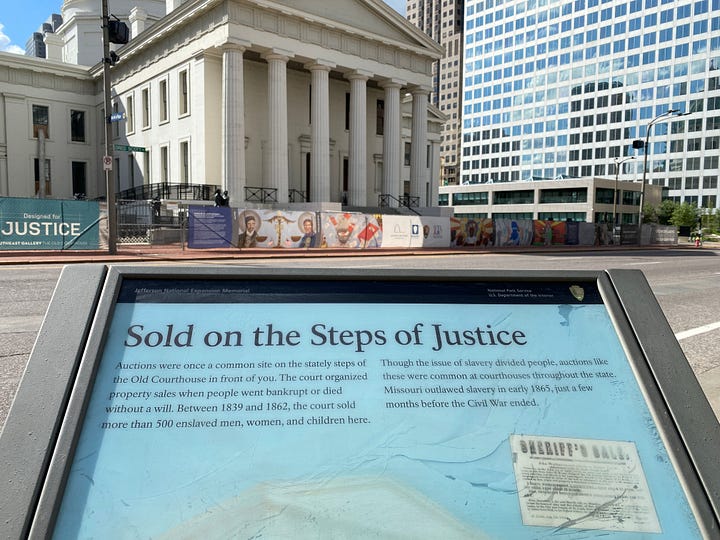
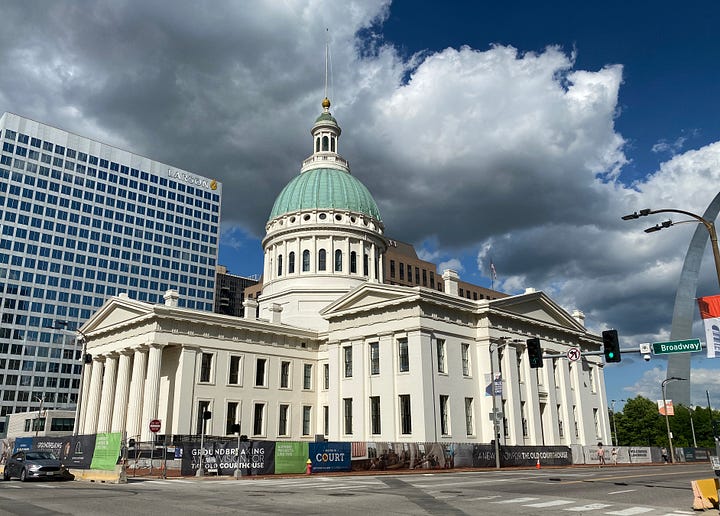
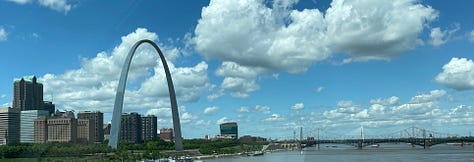
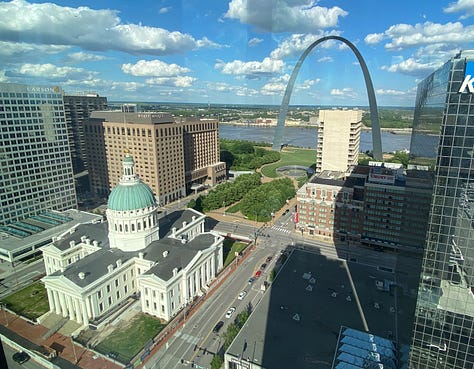
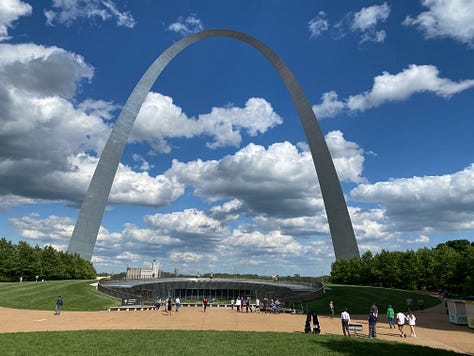


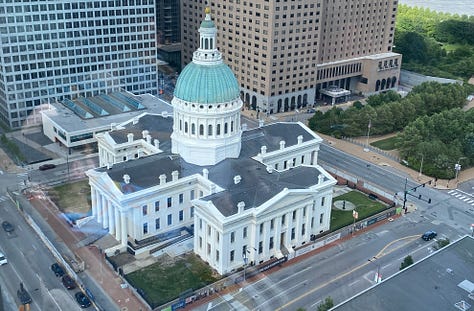
We visited the museum at the Arch. Bought tickets to go in the tram to the top. It is extremely high. (630 feet.) When we saw how cramped the rail cart was, we bailed. Clearly if somethign went wring being trapped in that cinfined space would be challenging. Instead, we spent ten minutes in their museum. Saw this (pictured) Sharps Rifle below their Buffalo model. A reminder of the Buffalo genocide.
The single shot rifle used by the cowboys who were paid $5 for each Bison scalp they brought in. The Governments anti Indian scorched earth policy. To kill off the buffalo herds after the Civil war allowed them to focus on more land grab genocide, in the late 1800’s. Scorched Earth; kill the Indians food supply and starve them out.
The most famous photograph of bison extermination is a grisly image of a mountain of bison skulls. It was taken outside of Michigan Carbon Works in Rougeville, Mich., in 1892. At the close of the 18th century, there were between 30 and 60 million bison on the continent. By the time of this photograph, that population was reduced to only 456 wild bison. Takes some thinking to imagine what the American Goverments ‘Manifest Destiny’ involved. With God’s will. Decided by Christians for Christians. Many of whom are still Christian in Government for Christian people.
Bison made the Prairies hospitable for many other communities. Each skull represents one 600-kilogram animal. Bison are the largest land mammals in North America. Bison are not just massive in size, they are also a keystone species in the West, meaning they have a dramatic influence on an ecosystem.
If one of these species disappears, no other species can fill its ecological role, and the whole ecosystem changes as a result. Each bison killed meant the end of grazing, wallowing and migrating practices that make the land hospitable for other species. Killing off the Indians food supply paired well with herding many into concentration camps and genociding most of the native population. It was interesting to see how this genocide was represented in the Arch Museum in St. Louis.
The Sharps Rifle. Possibly the start of monetizing the American military complex making guns for malign purposes promoting unregulated capitalist christian prosperity.
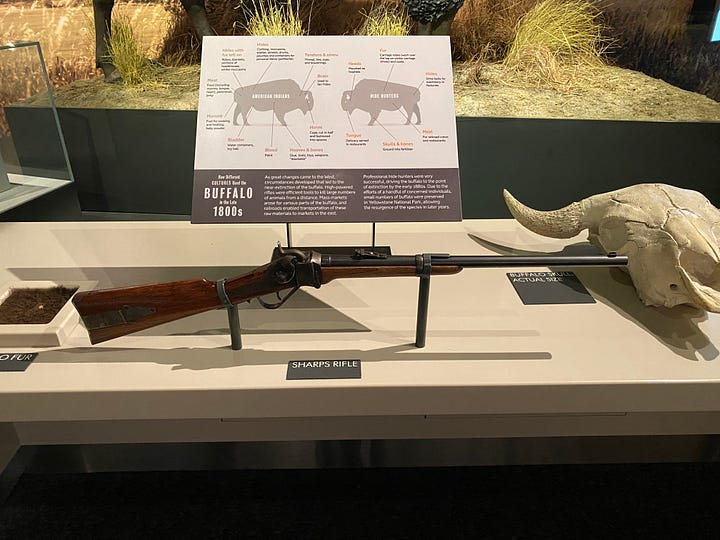
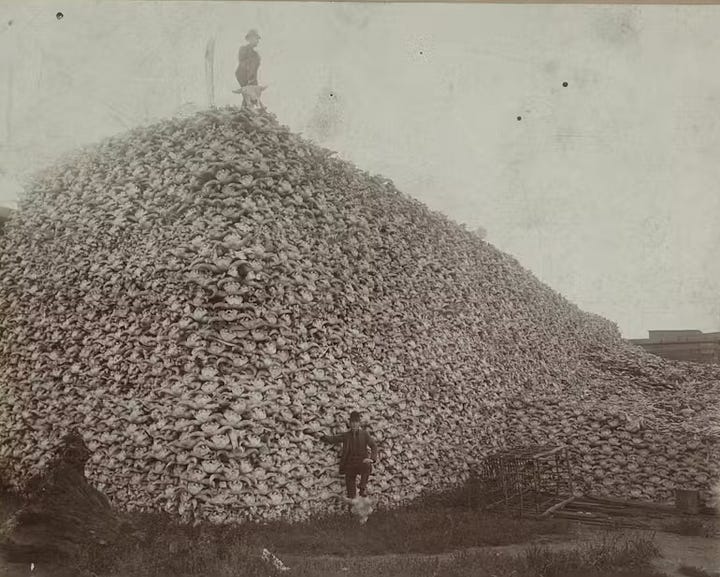
We visited the arch, passing many churches along the way.
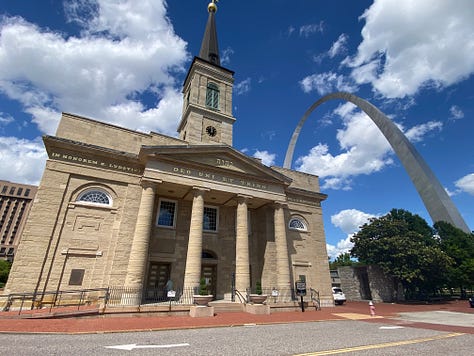
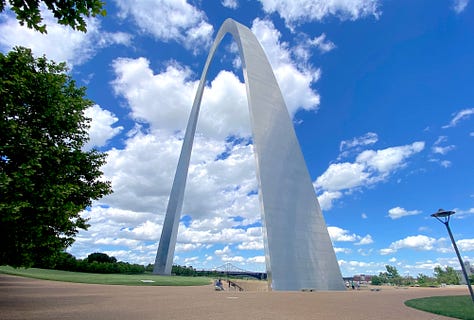
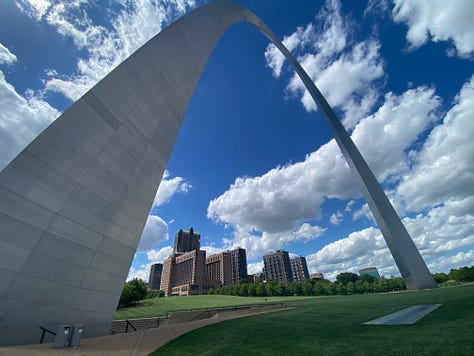

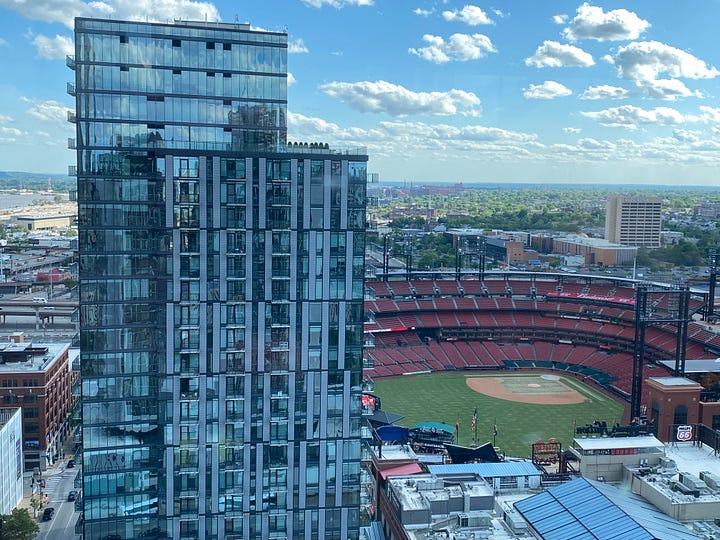
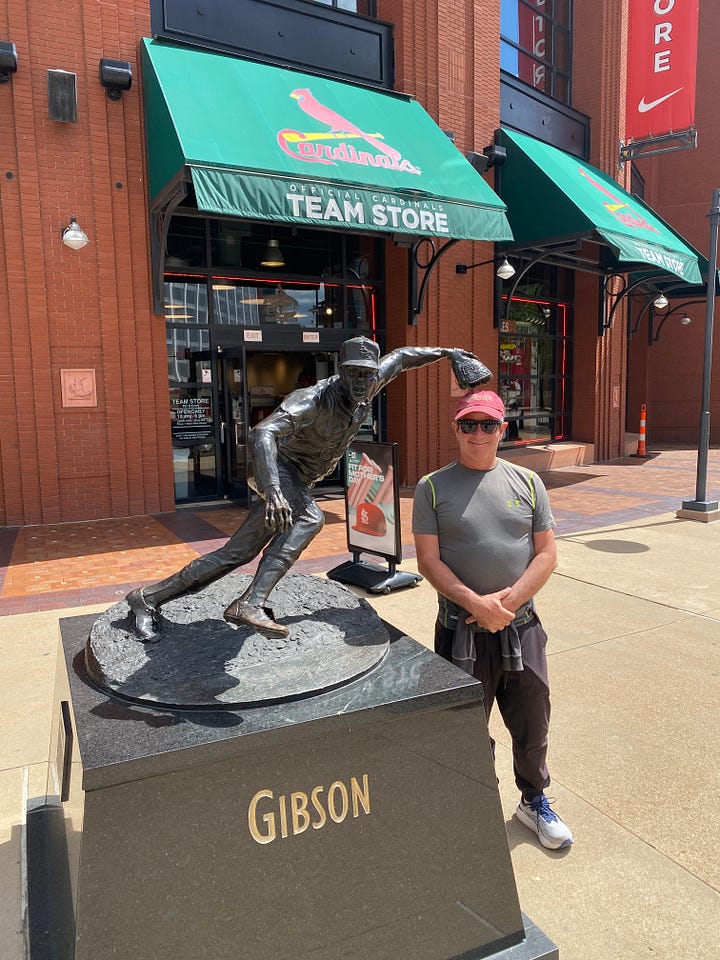
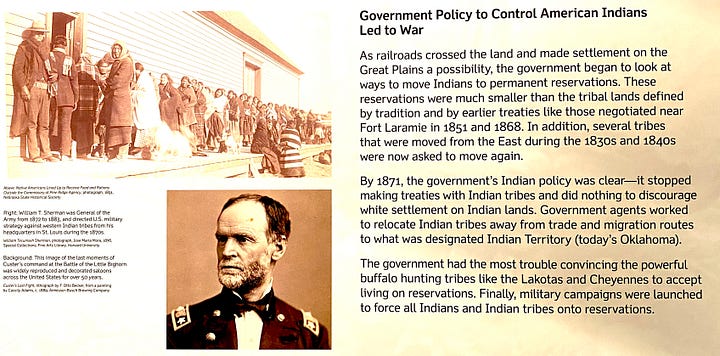
Our hotel is opposite original location of Lynch’s Slave Pen as well as the entrance to the Busch stadium. Home of the Cardinals. Baseball dominates St. Louis. I chose Bob Gibson as my ‘favorite.’ ball player for this photo opportunity. I don’t know much about the game.
I once met a baseball Hall of Famer which was some insight into the game and the people who play it. I still don’t know much about the game although I know more about the people who play it. I have the impression it is best suited for Christian conservatives.
Still; I learned Bob played his entire career for the St. Louis Cardinals from 1959 to 1975. Known for his fiercely competitive nature, Gibson tallied 251 wins, 3,117 strikeouts, and a 2.91 earned run average. A nine-time All-Star and two-time World Series Champion, he won two Cy Young Awards and the 1968 National League Most Valuable Player Award.
Funny that the baseball park is located on the same ground where so much slave trading took place.
Had a super dinner in St. Louis, ruminating over the crime numbers in this City. We saw one incident, a black man, in some distress, being tied down to a gurney by five white paramedics, and one black woman assistant. We haven’t seen that kind of incident before.
A guy who looked like a caricature of an FBI man from the movies, was looking on from a distance. As the black fellow was being tied down to the gurney, holding his head as if to protect it. The FBI looking guy appeared again passing us on the street later in the day. Weird. Feels like a surveilled city.
In 2014, St. Louis was ranked as the 19th most dangerous city in the world by the Mexican aid organization CCSP-JP (El Consejo Ciudadano para la Seguridad Publica y la Justicia Penal).
As of 2017, St. Louis is ranked as the most dangerous city in America. There were 66 homicides per 100,000 residents. This rate is more than 10 times the national homicide rate.
We felt an air of threat during our visit here. We have been in shock all day after standing on the location of that slave market.
Tomorrow we leave for Kansas City.


